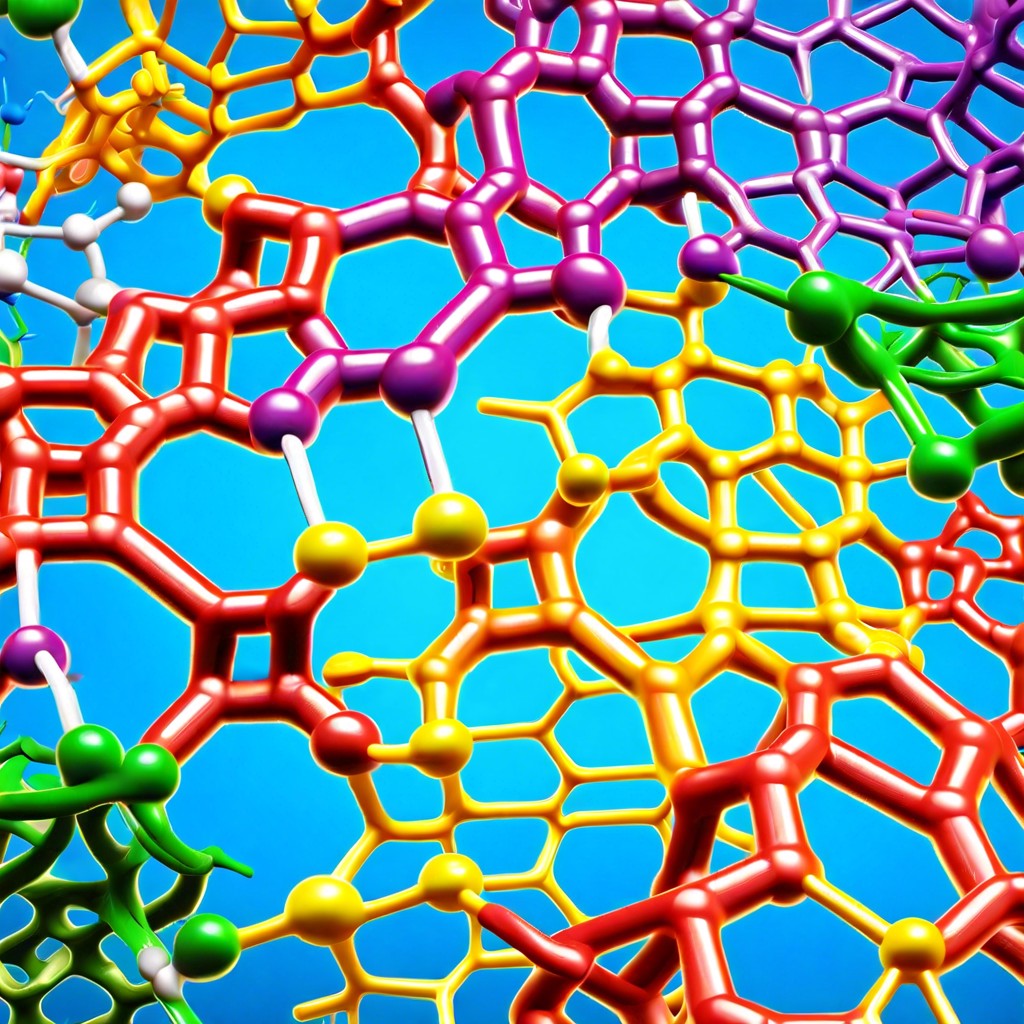In biological systems, a polymer is called a biomacromolecule, which you’ll discover is basically the molecular equivalent of Lego blocks for life!
Key takeaways:
- Biological polymers are called biomacromolecules.
- They include proteins, nucleic acids, carbohydrates, and lipids.
- Monomers link together to form complex polymers.
- Dehydration synthesis creates polymers by removing water.
- Polymer structure affects function and properties.
Biological Polymers

Imagine molecular chains that are like the coolest Lego sets ever. That’s essentially what these are – tiny building blocks called monomers linking up to form long, complex structures.
In living organisms, these polymers include proteins, nucleic acids (like DNA and RNA), carbohydrates, and lipids. They rarely travel solo; they usually form huge teams.
Proteins are the body’s construction crew, responsible for building and repairing tissues.
Nucleic acids store and transfer genetic information. Think of them as the ultimate data storage centers.
Carbohydrates are the go-to energy source, powering everything from marathon runners to midnight snack cravings.
And lipids? They make sure you have enough insulation and long-term energy storage, meddling in just about everything essential to stay alive.
Each of these polymers has a specific role, working tirelessly in every nook and cranny of biological systems. Pretty neat, right?
Different Types of Biological Macromolecules
Great, let’s jump right into the exciting world of biological macromolecules!
We’ll start with carbohydrates. These are the sugars, starches, and fibers found in fruits, grains, vegetables, and dairy products. Carbohydrates are your body’s main source of energy. Think of them as your body’s fuel. Seriously, who can turn down a good pasta dish?
Next, we have proteins. These are the workhorses of the cell, carrying out all sorts of tasks. They build muscle, fight off infections, and even help you feel those adorable puppy cuddles by playing a role in your nerve cells. Thank you, proteins, for making life both brawny and snuggly.
Now, let’s talk about lipids. These are fats, oils, and waxes. They store energy, insulate your body, and make up cell membranes. Without lipids, you’d be all energy-less and cold, and your cells would be floating in chaos. No one wants that.
Lastly, nucleic acids. You might know these superstars as DNA and RNA. They store and transmit genetic information. Essentially, they’re the blueprints that make you, well, you. Imagine them as the tiny architects of life.
To sum it up, biological macromolecules are pretty much the unsung heroes making life possible and amazing.
Monomers and Polymers
In the world of biological macromolecules, think of monomers as tiny building blocks. They’re the individual units that link together to form larger structures called polymers. Imagine monomers as Lego bricks. Alone, a single Lego brick isn’t particularly impressive, but snap a bunch together, and you’ve got the Millennium Falcon.
Take glucose, for instance. By itself, it’s just one sugar molecule. But string a bunch of glucose molecules together and, voila, you have starch, a polymer. Proteins work the same way. Amino acids are the monomers that hook up in chains to form proteins, the polymers.
Polymers are like a daisy chain of repeating units. Each little unit attaches to the next in a chain, joining forces to make something much more complex and, quite frankly, more interesting. And just like those Lego sets, the order and choice of monomers determine the final structure. Think chemistry meets construction zone!
Dehydration Synthesis and Hydrolysis
Dehydration synthesis, also known as condensation reaction, is like Nature’s way of playing with Lego blocks. Imagine you have two building blocks (monomers), and you’re so excited to join them together that you throw out a water molecule in the process. The removal of water (H2O) creates a bond between the monomers, forming a polymer. This is how complex molecules like proteins and carbohydrates are built in biological systems.
On the flip side, hydrolysis is a bit like a wrecking ball in a demolition derby. It breaks down polymers into their monomer units by adding water. When a polymer needs to be broken down into simpler components, water swoops in and helps to chop-chop everything apart. This process is crucial for digestion in our bodies, turning big, energy-rich molecules into smaller, absorbable units.
Structural Features of Polymers
Polymers in biological systems have fascinating structural features, almost like the blueprints of a Lego masterpiece. Here are a few key points:
Length Matters: The length of the polymer chain can affect its function. Short chains often have different properties than long, sprawling ones, kind of like the difference between a jump rope and a slinky.
Branching Out: Some polymers have branches sticking out from the main chain. Imagine a tree with its branches going off in all directions. These branches can influence the polymer’s properties and reactivity.
Twists and Turns: Polymers aren’t just boring straight lines. They can twist and fold into specific shapes, which is crucial for their function. Think of a protein folding into a three-dimensional shape, like an intricate origami piece.
Super Glue: Polymers can form special bonds with each other called cross-links. These are like the superglue that can make the polymer network more rigid or elastic. It’s like having reinforced concrete instead of a simple brick wall.
Monomers in a Line: The sequence of monomers in the polymer matters a lot. It’s like how the order of letters forms different words. One sequence may code for a muscle protein, while another codes for an enzyme.
Understanding these features makes it clear why biopolymers are so cool. They’re the high-tech machinery in the world of biology!
Recap




